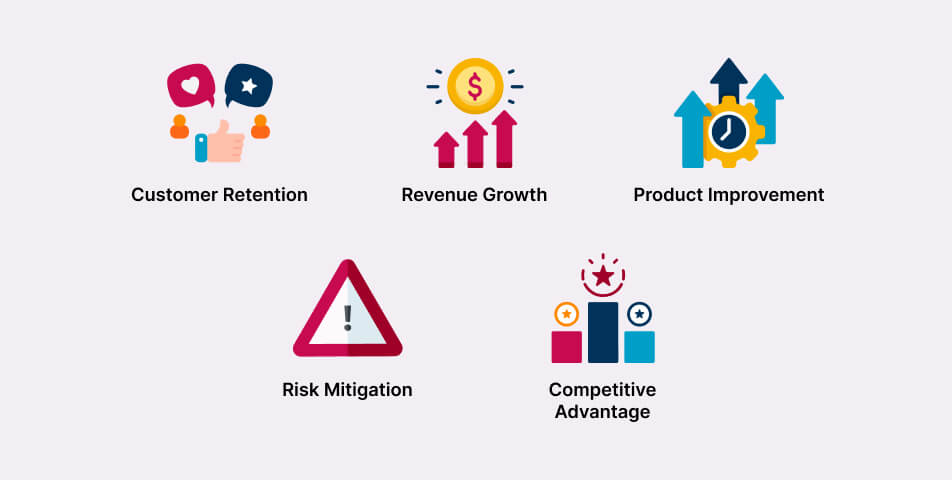The customer success journey has become one of the most determining factors to ensure the long-term success of a business because;
Happy customers, Happy Business!
Today at any business, we do not aim to acquire customers, we aim to retain them. It feels like euphoria to imagine having customers all the time who love our business, keep on buying from us, share amazing feedback about our products, and come back to us time and again.
Well, this euphoric feeling feels blissful to imagine, but turning this into reality is challenging.
To make the challenge more accessible, we take help from the most helpful and go-to tool that promises your customers the right way to help them achieve satisfaction with our products.
Key Takeaway :
Crafting a customer success journey is crucial for the long-term success of a business. It involves defining success for the customer, observing the stages of the journey, mapping customer touchpoints, focusing on every milestone, identifying customer success at each milestone, and finding opportunities to improve the journey.
What is a Customer Success Journey?
A customer success journey map is a visual representation of the varied steps that a customer can choose to take to achieve maximum success with a product or service.
The concept thrives on outlining the different phases that all the customers of one business go through as they hear and about, get interested in, make a purchase, buy/invest, use, maintain, and renew a product or service.
It should be a crystal-clear and visual representation of all the interactions, touchpoints, and milestones the customer has with the company and its product, from the point of purchase through the process of renewal.
By mapping out this entire journey only, companies can achieve success for themselves because after identifying areas for improvement, and working on them, enhanced customer retention rates, and have driven ultimate business growth.
What are those steps that provide the ultimate customer success journey? Let us know:
6 Steps for the Ultimate Customer Success Journey Map

Much has been said about the effectiveness of the customer success journey map and how they guide the business in evaluating the success they were able to make with a customer’s experience associated with the purchase of a product or service.
Let’s know more about the steps to create the ultimate customer success journey map
1. Define success for your customer
If you as a business are not finding the root cause of providing a successful journey to your customers by using your products, then how will you make the result happen?
The first step to defining a map for your customers to follow is only going to happen when you know what your customer wants, what their success with buying your product looks like for them, and what they truly expect from your business.
2. Observe the stages of a customer success journey
A customer success journey is never a one-step process, but a many-step one. Only identifying the various stages will get you closer to understanding the outlook of your customer success journey map and how it can be aligned with your customer’s expectations:
Making a Purchase
When customers finally decide to purchase your product or avail of your services. Know their expectations and reason for making a purchase
The Onboarding Process
In this step, your customer has started using your product. This is where your customers are getting to know more about the utility of your product, as they are using your product for the first few uses.
The Adoption
This is the most important step of your customer success journey map. Here, the customer mindfully and religiously uses your product to extract the proper value from it.
If they use it once or twice or probably a few times as compared to continuously or frequently using it, then you might not have helped them achieve success after using your product.
Retention
We always say that if a business is successful with customer retention, then only they have been successful with the business.
In the retention stage, a customer has tried, tested, and reviewed your product. He/she is now deciding if to continue using your product or not. If they continue, the situation is a renewal and if they stop using it, that leads to their churn rate.
An ideal customer success journey map allows your customers to find the maximum success with the journey that you recommend them to take and then renew at the end of their contract.
The Renewal
Your customers may have outgrown the existing plan for which they had initially bought and used your products. Maybe you have something reserved for your customers that can add better value to their success.
It is a very important step of your customer lifecycle. If you find a customer who should be worth, up-selling and cross-selling products from your business, now is the fair time to grab the opportunity to expand their success journey with your business.
The Consulting
If a customer has achieved the goals by using your products, they start voicing your products to other people. They do it by reviewing your products, recommending them to their friends and family, etc. In short, they become your brand advocators.
3. Mapping the customer touchpoints
Touchpoints refer to all the times a customer or the prospects have interacted with your product. Some points mentioned below are examples of the customer touchpoints where customers are found to interact with your company and its products and services:
Company Website – Examples are the HomePage, Pricing Page, Login Page, and the Landing Page.
- Social Media content
- Sales Calls
- Product Onboarding Process
- Emails – marketing and products
- Trials and demos of products and services
- Customer Support
- Cancellation flow
- Renewal Process
Read More:7 Customer Success Software Tools to Encourage Growth
4. Focus on every milestone
To identify success milestones through a customer success journey map, we must look at all the above-mentioned touchpoints to identify what the customers want to achieve as success at every milestone.
Ask your customers what they want to experience from your business to achieve customer success at one particular milestone only, and you try to make that exact thing happen for that milestone.
For example: For a social media live where you are reviewing your products, you may try the product in front of your live audience and make them achieve confidence in your products and boost customer success because you are now one of them while using the product.
5. Identify customer success at each customer milestone
For the several milestones that you have set for customer success, determine what customer success looks like for those milestones and include them in your customer success journey map.
By now, you might have figured out what your customers want and expect from your business. With a better understanding of the customer milestone, it is not just the onboarding process to the renewal process.
Customer Milestone is fulfilling the expectations that customers have with us. Fullfill the customer expectations, that is your milestone achieved.
6. Find opportunities to improve the customer’s journey
In building a customer success journey map, it’s crucial to track both successes and failures. Mark unsuccessful attempts as red flags on the map to alert your team to areas needing improvement.
These red flags can indicate customer dissatisfaction or shortcomings in achieving business goals. To optimize your journey map, be proactive in seeking opportunities for improvement.
Why customer success journey is important in the business?

A customer success journey is a prior thing to look forward to in the business. From planning to executing, it is important to have the proper roadmap and the planning.
Let’s understand that one by one:
- Customer Retention: A well-designed customer success journey helps in retaining customers by ensuring they are satisfied and engaged with your product or service.
- Revenue Growth: Satisfied customers are more likely to make repeat purchases and recommend your business, contributing to revenue growth.
- Product Improvement: Tracking customer interactions and feedback through the journey map can highlight areas for product or service improvement.
- Risk Mitigation: Identifying red flags early on allows you to proactively address issues, reducing the risk of customer churn.
- Competitive Advantage: A strong focus on customer success sets you apart from competitors and builds long-term relationships with your customer base.
How can Desku help in the Customer Success Journey?
When it comes to the customer success journey, it is an important aspect of any business. For the customer success journey, the most important thing is that business provides the streamlined support to its customers.
Some of the key features of Desku help to streamline the customer success journey;
- Unified Shared Inbox for streamlining support and the coordination between customer support agents and customers.
- AI-Helpdesk Customer Support for automating the repeated tasks.
- Proactive Live Chat for instant support to common queries along with an embeddable knowledge base and chatbot
- No Code Chatbot Builder for automated support to customers in the absence of any support agent.
and much more
One of the key aspects of providing the customer success journey is to provide consistent customer engagement.
Customer Success Journey to be understood
Every business requires a successful customer success journey and a customer success journey map is one way to make that easily possible. Desku is here that will help you to execute the customer success journey in the business.
Make sure to figure out the strategies for yourself and highlight both successes and failures for your business in your customer success journey map for the best results.
FAQs
1. What is a Customer Success Journey Map?
A customer success journey map is a visual representation of all the steps, touchpoints, and milestones a customer experiences with your business. It outlines the journey from the first interaction through product adoption, retention, and renewal. This map helps businesses identify areas of improvement to ensure customer satisfaction and loyalty.
2. Why is customer success important for businesses?
Customer success ensures that customers achieve their goals using your products or services. It directly impacts key business metrics like:
Retention: Satisfied customers are more likely to continue using your product.
Revenue Growth: Happy customers make repeat purchases and recommend your business.
Risk Mitigation: Identifying pain points early prevents churn.
Product Enhancement: Feedback during the journey helps refine offerings.
4. What are some challenges in creating a customer success journey map?
Some common challenges include:
Identifying customer needs: It can be tough to align the journey with unique customer expectations.
Managing data: Mapping the journey requires gathering and analyzing data from various channels.
Keeping the map updated: Customer expectations evolve, so the map must adapt to changes over time.


